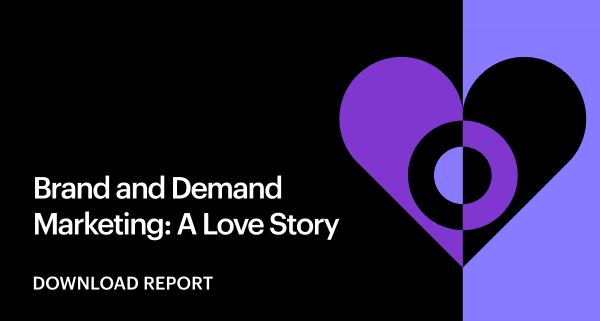BLOG
Brand and Demand Marketing: A Love Story
Marketing has always been shaped by shifts in consumer behavior, expectations and technology advancements, as well as its contribution to the enterprise. As the scope and speed of such changes expand and accelerate, it is more difficult for brands to know which types of campaigns and media work best, and the growth to which marketing can contribute.
They must make hard tradeoffs in deciding where to invest finite resources, how to differentiate amongst competitors and how ambitious they need to be as a growth engine. Are the tradeoffs—and competition between forces—helpful or harmful?
Today’s marketing industry feels different, according to our recent candid conversations with a dozen senior marketing leaders across industries. Customers are harder to reach and engage, even though we have vastly more data and insights about them and stronger personalization tools. Budgets are tighter and internal stakeholders more demanding. Tried-and-true best practices no longer apply. There’s a sense that rules are being rewritten in real-time. The once useful “marketing funnel” concept seems less relevant given that consumer behavior changes constantly and paths to purchase are increasingly non-linear.
As a result, many marketing organizations experience significant tension between brand marketing and demand generation – a tension we believe undercuts growth and harms performance. Brand marketing typically describes long-term efforts to drive awareness of and preference for a company, product or service, while demand marketing seeks to get audiences to take action immediately (e.g., click on an offer, sign up for a newsletter).
“This topic is one of the things that we’ve [been] trying to understand – where in the funnel do we need to spend our dollars in order to really drive business results and drive growth.”
– TD Bank, CMO
As the CMO of a challenger consumer goods brand told us, “Brand is about growing awareness and affinity over time,” while the primary objective for demand, or performance marketing, is “driving short-term conversion.”
The “either-or” bifurcation of marketing into these categories presents huge challenges as marketers seek to optimize budget allocation, track performance and structure their teams and operations to drive uncommon growth. The worst part, the split between brand and demand generation isn’t aligned with consumers’ consumption patterns in today’s world.
As a senior industry analyst told us, “Consumers have zero separation between the brand being communicated and their experience. In finding the right investment for brand and demand, it’s both, not versus.”
Stop the fighting and find the love.
This article, the first in a series, is based on our recent market research with senior marketing executives and focused on the specific internal and external challenges CMOs face today related to brand and demand. These marketers also highlighted the levers they have at their disposal to create effective and integrated brand and demand strategies.
Every marketing executive we talked to confirmed the importance of finding the right balance between brand and demand. We also heard repeatedly what a difficult balance it is to strike; everyone agrees that brand and demand efforts must be coordinated and synchronized. However, how to do this is much less clear. Despite the interdependence of brand and demand marketing, many tricky questions remain:
- How much impact does brand marketing have on conversion?
- How does customer acquisition efforts influence brand perception?
- What’s the optimal level of investment across brand and demand?
- How can brand and demand show up most effectively across channels?
“This topic comes up all the time, in the B2B context, the brand piece is a hard sell because our team doesn’t understand why it’s important.”
– Trane Technologies, SVP of Marketing
In our brand and demand blog series, we explore this important conversation with a modern lens, examining how marketers can embrace the brand-demand love. Specifically, we’ll cover:
- The seasons of love: Understand why brand and demand are meant to be together and how they can overcome obstacles to love across the marketing lifecycle – we’re playing a long game
- Writing the vows: Set a strong strategic foundation, because every brand-demand marriage needs a rock-solid foundation of what it stands for and how it will approach the market – when to say “I do” and when “I don’t”
- Shared finances: Create shared goals and an investment agenda, define smarter metrics for allocating the shared pocketbook, or budget, and track the performance of those shared investments – brand and demand should not fight about money
- Setting up the household: Determine how to organize teams and build the right capabilities – brand and demand need a comfortable nest

The new research report, “Brand and Demand: A Love Story” is here! Learn how today’s Brand and Demand Generation leaders are bringing their functions together to drive greater impact.
Download today!
FINAL THOUGHTS
We think it’s time for brand and demand to stop thinking of themselves as competing interests fighting for the same precious resources. Rather, they must be complementary companions with a shared agenda and intertwined goals. We believe it’s time for brand and demand to fall in love because together, they are the ultimate power couple to build relevance and unlock uncommon growth.
Get in touch today if you’d like to learn how to bring brand and demand together to unleash the full power of your business.



